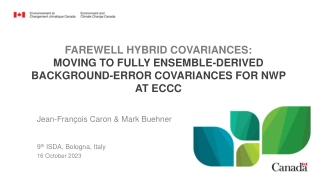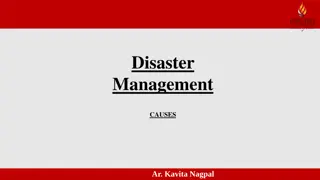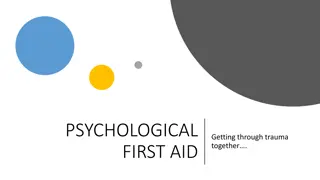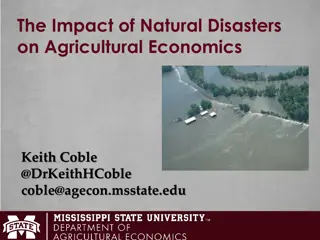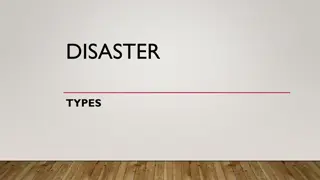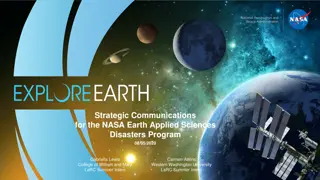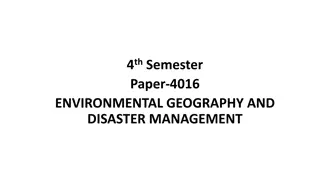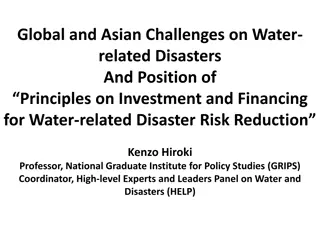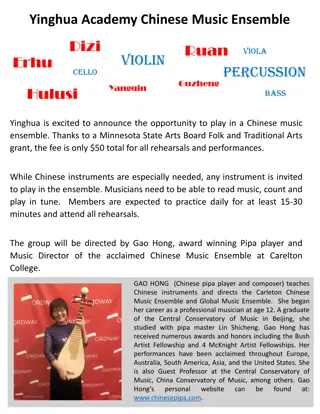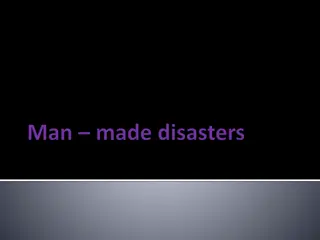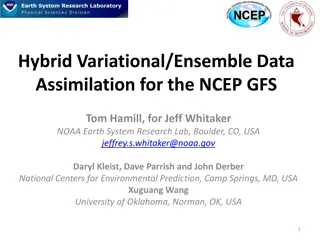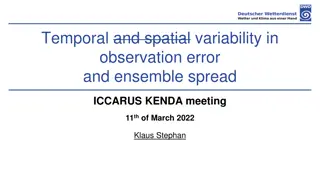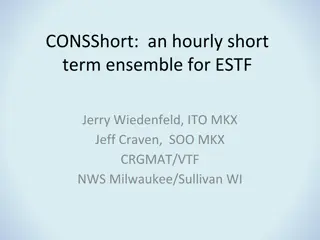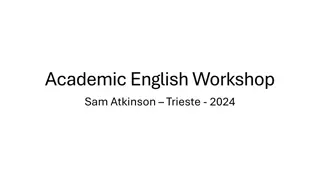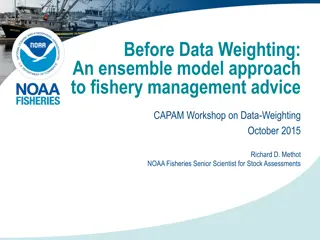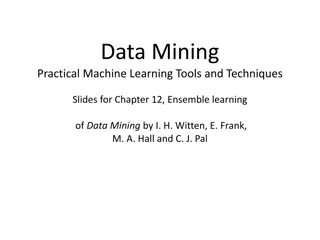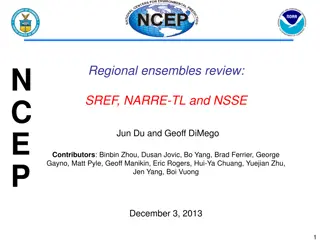Ensemble Deep Learning for Building Assessment After Disasters
Efficient post-disaster building assessment using UAV imagery and deep learning for rapid and accurate damage evaluation to aid rescue and reconstruction efforts.
Download Presentation

Please find below an Image/Link to download the presentation.
The content on the website is provided AS IS for your information and personal use only. It may not be sold, licensed, or shared on other websites without obtaining consent from the author. Download presentation by click this link. If you encounter any issues during the download, it is possible that the publisher has removed the file from their server.
E N D
Presentation Transcript
A Stacking Ensemble Deep Learning Approach for Post-Disaster Building Assessment using UAV Imagery Presenter: Leon Sim Advisor: Assistant Prof. Szu-Yun Lin Department: Construction Engineering and Management
Outline Background Literature Review Methodology Deep Learning & Object Detection YOLOv5 Mobilenet Datasets Stacking Ensemble Results Future Work Conclusion 2
Background Post-Disaster Building Damage Assessment When a natural disaster strikes, assessing the damage caused to buildings is crucial for planning efficient rescue operations and reconstruction efforts. Rapid and accurate damage assessment enables authorities to allocate resources effectively, prioritize the hardest-hit areas, and provide timely support to affected communities. 4 Fig. 2. UAV deployed at the affected area.
Background Preliminary damage assessment Traditional way: Ground-based surveys Time-consuming and labor-intensive Limited coverage and accuracy Fig. 1. Response team surveying affected area. Modern way: UAV imagery and Deep Learning Faster and more efficient Wider coverage and higher resolution Fig. 2. UAV deployed at the affected area. 5
Background Comparisons of Existing Remote Sensing Techniques Satellite Imagery: Lower spatial resolution Affected by atmospheric conditions (clouds, haze) Less frequent image updates UAV Satellite Quality Precision Ease of deployment Autonomy Accessibility UAV Imagery: Higher spatial resolution for detailed analysis Less affected by atmospheric conditions More frequent updates and on-demand data collection Table 2. Comparisons of UAV and satellite images 6
Background Challenges in UAV Datasets Large intra-class variation Small inter-class dissimilarity Imbalanced data 7
Background Challenges in Damaged Building Assessment Ambiguous Classification - the damage type of the dataset confused the AI model (No damage, Minor damage, Major damage, Destroyed) Data imbalance normally the quantities of Major damage and Destroyed are much less than the others. Degree of Damage No damage Definition no structural damage, habitable without repairs uninhabitable, repairs can be completed in less than 30 days uninhabitable, extensive repairs required that will take more than 30 days to complete total loss, permanently uninhabitable Minor Fig. 3. Every instance from each damage class in our dataset. Major Destroyed Table 1. Definitions of four structural losses by FEMA. 8
Background Motivations of the study Enhance disaster response: Faster and more accurate damage assessment Prioritize resource allocation and rescue efforts Support recovery planning: Better understanding of damage patterns Informed decision-making for rebuilding and infrastructure improvements Advance technology in the field: Develop and refine state-of-the-art deep learning models Address challenges and limitations of existing techniques Contribute to disaster preparedness: Inform policy and planning for future disasters Strengthen resilience of communities and infrastructure 9
Literature Review Remote Sensing based building damage assessment Ehrlich, D., Guo, H. D., Molch, K., Ma, J. W., & Pesaresi, M. (2009). Identifying damage caused by the 2008 Wenchuan earthquake from VHR remote sensing data. International Journal of Digital Earth, 2(4), 309-326. Very High Resolution (VHR) satellite imagery potential for post-earthquake damage assessment compared to aerial photos. Satellite data helpful in identifying collapsed buildings, destroyed transportation, and land cover changes. Challenges in differentiating damage types and limitations in data availability and processing because it performed a change detection analysis by comparing pre- and post-disaster imagery. Fig. 6. Pre-disaster and Post-disaster Imagery in this study. 11
Literature Review GIS based building damage assessment Boccardo, P., & Tonolo, F. G. (2015). Remote sensing role in emergency mapping for disaster response. Geomatics, Natural Hazards and Risk, 6(3), 183-203. Geospatial information: Data with a geographic component. Sources: Satellite imagery, aerial photography, ground-based sensors. Uses: Disaster extent and severity assessment, critical infrastructure and resource location. Limitations: Limited resolution, cloud cover, atmospheric interference, cost. 12
Literature Review Deep Learning based building damage assessment on Satellite Imagery Cheng, G., & Han, J. (2016). A survey on object detection in optical remote sensing images. ISPRS Journal of Photogrammetry and Remote Sensing, 117, 11-28. Four method categories: 1. Template matching: Comparing template images to detect objects; rigid (fixed shapes) and deformable (varying shapes) templates. 2. Knowledge-based: Using prior knowledge (geometric and context information) to improve detection accuracy. 3. OBIA-based: Object-Based Image Analysis; image segmentation and object classification for detecting complex objects. 4. Machine learning based: SVM, AdaBoost, ANN Datasets & Metrics: Five public datasets and three standard evaluation metrics reviewed. Future directions: Deep learning-based feature representation and weakly supervised geospatial object detection. 13
Literature Review Deep Learning based building damage assessment on UAV Imagery Fernandez Galarreta, J., Kerle, N., & Gerke, M. (2015). UAV-based urban structural damage assessment using object-based image analysis and semantic reasoning. Natural Hazards and Earth System Sciences, 15(6), 1087-1101. Contributions UAV-based damage assessment approach Object-based image analysis and semantic reasoning Urban structural damage evaluation Limitations Dependence on high-quality imagery Limited to urban environments Potential issues with object occlusion and shadows Fig. 6. The 3-D point clouds used to identify the mentioned damage features. 14
Literature Review Convolutional neural networks for object detection in aerial imagery Pi, Yalong, Nipun D. Nath, and Amir H. Behzadan. "Convolutional neural networks for object detection in aerial imagery for disaster response and recovery. " Advanced Engineering Informatics 43 (2020): 101009. Deep learning for disaster impact assessment CNN models for aerial object detection Challenges: resource-intensive, offline computing Emphasize accurate, timely data crucial for disaster management Fig. 5. Example of IoU in aerial object detection. 15
Literature Review Tackle Challenges in UAV image Object Detection How to Fully Exploit The Abilities of Aerial Image Detectors Junyi Zhang et al. (2019) Targeting the problems of object detection with UAV images: Small Object Imbalanced quantity in different classes Finding difficult regions with predicted box scores, and then re-trained with their network- Difficult Region Estimation network(DREN) Fig. 5. The workflow of DREN. 16
Literature Review Dual Neural Network - 1 MSNet: A Multilevel Instance Segmentation Network for Natural Disaster Damage Assessment in Aerial Videos Xiaoyu Zhu et al. (2021) MSNet, contains novel region proposal network and an refinement network for confidence score refinement in both bounding box and mask branches. unsupervised score Fig. 6. The workflow of MSNet. 17
Literature Review Dual Neural Network - 2 Deep learning for post-hurricane aerial damage assessment of buildings Chih-Shen Cheng et al. (2021) Stacked PDA model contains two models, Model L for the localization tasks and Model C for the Classification tasks. Fig. 7. The workflow of model L and model C combination. 18
Literature Review Stacking Ensemble based approach Wolpert, D. H. (1992). Stacked generalization. Neural networks, 5(2), 241-259. Stacked generalization is a technique used to improve the accuracy of computer models that make predictions. It works by combining the predictions of multiple models to create a more accurate final prediction. Fig. 8. The two stages Involved in the implementation of stacked generalization. 19
Methodology Deep Learning for Computer Vision AI computer vision technique: Image Classification AI Class: Building model Input Output 21
Methodology Deep Learning for Computer Vision AI computer vision technique: Object Detection No damage Minor AI model Input Output 22
Methodology Mobilenet An efficient Convolutional Neural Network (CNN) developed by Google in 2019. Lightweight: It uses less parameters and computations to do the inference while remaining its precision. Efficient bottleneck structure: MobileNet V3 employs an improved bottleneck structure that helps reduce the model's computational requirements and parameters. H-Swish activation function: MobileNet V3 introduces a new activation function called H-Swish which maintains good performance while having lower computational overhead, making the model more efficient. Channel attention: MobileNet V3 uses a technique called Squeeze-and-Excitation (SE) modules, which improve feature representation by adaptively adjusting the relationships between channels. 23
Methodology YOLO v5 One-stage & Two-stage detector One-stage detector: SSD, YOLO family, RetinaNet Two-stage detector: R-CNN, Fast R-CNN, Faster R-CNN Pros of one-stage detector: Faster, Smaller Cons of one-stage detector: Less accurate 1) Backbone - A convolutional neural network that collects and forms image features at different levels of detail. 2) Neck -A series of layers to mix and combine image features to pass them forward to prediction. 3) Head - Consumes features from the neck and takes box and class prediction steps. Fig. 11. The comparison of one stage and two stage detector. Fig. 10. The network architecture of YOLO. 24
Methodology The confusion matrix of the prediction Testing results of YOLOv5 0: No damage 1: Minor 2: Major 3: Destroyed Images Instances P R mAP50 mAP50-95 1629 all 0.635 0.614 0.62 0.405 0.829 0.804 0.526 918 No damage 0.678 205 (ISBDA validation) 523 Minor damage 0.615 0.664 0.646 0.425 107 Major damage 0.539 0.43 0.452 0.312 0.707 81 Destroyed 0.531 0.577 0.355 Table 5. Testing results of YOLOv5 on validation dataset. The performances of the "minor" and "major" classes are unsatisfactory. Fig. 12. The confusion matrix of the results on validation dataset. 25
Methodology Testing results of YOLOv5 0: No damage 1: Minor 2: Major 3: Destroyed Fig.13. Precision-Recall Curve of the YOLOv5 detections. 26
Methodology Combining Predictions from YOLOv5 & Mobilenet Input images Testing results from training dataset {x1, y1, x2, y2, no_conf, min_conf, maj_conf, des_conf, pred_cls} Training weights YOLO v5 Object Detector Input images (cropped building images) Classification results { slight_conf, severe_conf} Trained Classifier Mobilenet Classifier Goal: We wish to enhance the classification between minor damage and major damage 27
Methodology UAV Images Cropped Building Images Data YOLO v5 Level-1 classifiers (base models) Mobilenet [x1, y1, x2, y2] YOLO v5 predictions for each building [x1, y1, x2, y2, no_damage_conf, minor_damage_conf, major_damage_conf, destroyed_conf] Mobilenet predictions {slight_conf, severe_conf} Level-1 predictions Level-2 classifier (meta learner) Neural Network Final Predictions Level-2 prediction (Final predict) {no_damage_conf, minor_damage_conf, major_damage_conf, destroyed_conf} 28
Data 29
Data Datasets Training Dataset: The actual dataset that we use to train the model (weights and biases). The model sees and learns from this data. Validation Dataset: The validation set is used to evaluate a given model. We use this data to fine-tune the model hyperparameters. Hence the model occasionally sees this data, but never does it Learn from this. We use the validation set results, and update higher level hyperparameters. Test Dataset: It provides the gold standard to evaluate the model, and is only used once a model is completely trained Fig. 3. Visualization of how dataset is split before AI training and testing. 30
Data ISBDA dataset Originated from MSNet paper 1030 images were collected from social media platform in the aftermath of several hurricane disasters. Damage States Slight Severe Debris Count 2119 560 282 Table 1. The distribution of the original dataset Figure 8. The annotations of the original dataset 31
Data Dataset 1 YOLOv5 Training Data Test Data Contains 10% of the modified ISBDA dataset with ground truth and labels. Contains 70% of the modified ISBDA dataset with ground truth and labels. Validation Data Contains 20% of the modified ISBDA dataset with ground truth and labels. Damage States Slight Severe Debris Count 2119 560 282 Table 3. The distribution of the original dataset Damage States No Damage Minor damage Major Damage Destroyed Figure 9. The annotations of the modified dataset Count 4650 2597 494 381 32 Table 4. The distribution of the modified dataset
Data Dataset 2 Mobilenet Test Data Training Data Cropped building images from training dataset (Dataset 1). Predictions from YOLOv5 on test dataset (Dataset 1). We will get a set of predictions of each building {[x1, y1, x2, y2, class 0 prob., class 1 prob., class 2 prob., class 3 prob., pred. class] * N} from the inference of YOLOv5 Classification Mobilenet designed only responsible for predicting two damage classes, which are slight and severe . For training, we combined the instances of no damage & minor from Dataset 1 into slight , while combining the instances of major & destroyed into severe . 33
Data Dataset 3 Meta learner Training Data Combined predictions of YOLOv5 and Mobilenet on validation (Dataset 1). Test Data Combined predictions of YOLOv5 and Mobilenet on test dataset (Dataset 1). dataset Predictions from Mobilenet Predictions from YOLOv5 x1 y1 x2 y2 no damage minor major destroyed best_conf yolo_pred prob_0 prob_1 mobile_pred label Targets Training features 34
Results 35
Results YOLOv5 vs. Stacking Ensemble on test dataset YOLOv5 (Baseline) Stacking Ensemble (Neural Network as meta learner) 36
Results YOLOv5 vs. Stacking Ensemble on test dataset YOLOv5 (Baseline) Stacking Ensemble (Neural Network as meta learner) 37
Future Work 38
Future Work Review the experiment process to find where is the problems. Investigate alternative stacking techniques: Explore different stacking methods, architectures, or the use of additional models to enhance the overall performance and address the identified weaknesses in major damage classification. Optimize the meta learner: Further fine-tune the meta learner's architecture and training process to improve the balance between precision and recall, as well as the mAP50 and mAP50-95 metrics. Feature engineering: Experiment with different feature combinations or feature extraction techniques to improve the information fed into the stacking ensemble and enhance the final classification results. 39
Conclusion 40
Conclusion The goal of this study is to perform a preliminary damage assessment on buildings captured by UAVs while focusing on using Stacking Ensemble approach to improve the classification task. The stacking ensemble approach using YOLOv5 and Mobilenet has demonstrated improvements in precision and mAP50-95 while sacrificing recall and slightly reducing mAP50. This approach needed to be carefully revised in order to achieve better overall performance and provide a more robust solution for post-disaster housing damage detection and classification. 41
References Weber, Ethan, and Hassan Kan . Building Disaster Damage Assessment in Satellite Imagery with Multi-Temporal Fusion. 0 0 2004, https://arxiv.org/abs/2004.05525. Kerle, Norman, et al. UAV-Based Structural Damage Mapping: AReview. MDPI, www.mdpi.com, 26 Dec. 2019, https://www.mdpi.com/2220-9964/9/1/14. Zhu, X., Liang, J., & Hauptmann, A. (2021). Msnet: A multilevel instance segmentation network for natural disaster damage assessment in aerial videos. In Proceedings of the IEEE/CVF Winter Conference on Applications of Computer Vision (pp. 2023-2032). Jocher, G.; Stoken,A.; Borovec, J. Ultralytic/Yolov5. Available online: https://github.com/ultralytics/yolov5. Roboflow. (2022). Available Online https://roboflow.com/ Gupta, Gupta, R., Goodman, B., Patel, N., Hosfelt, R., Sajeev, S., Heim, E., ... & Gaston, M. (2019). Creating xBD: A dataset for assessing building damage from satellite imagery. In Proceedings of the IEEE/CVF conference on computer vision and pattern recognition workshops (pp. 10-17). Kortmann, F., Talits, K., Warnecke, A., Meier, N., Heger, J., Drews, P., & Funk, B. The Value of Deep Learning Tools in Object Detection: YOLOv5 in a Road Damage Use Case. A. Farhadi and J. Redmon, Yolov3: An incremental improvement, in Computer Vision and Pattern Recognition, 2018, pp. 1804 02 767. Lin, T. Y., Goyal, P., Girshick, R., He, K., & Doll r, P. (2017). Focal loss for dense object detection. In Proceedings of the IEEE international conference on computer vision (pp. 2980-2988). Kingma, D. P., & Ba, J. (2014). Adam: Amethod for stochastic optimization. arXiv preprint arXiv:1412.6980. Ehrlich, D., Guo, H. D., Molch, K., Ma, J. W., & Pesaresi, M. (2009). Identifying damage caused by the 2008 Wenchuan earthquake from VHR remote sensing data. International Journal of Digital Earth, 2(4), 309-326. Boccardo, P., & Tonolo, F. G. (2015). Remote sensing role in emergency mapping for disaster response. Geomatics, Natural Hazards and Risk, 6(3), 183-203. Cheng, G., & Han, J. (2016). Asurvey on object detection in optical remote sensing images. ISPRS Journal of Photogrammetry and Remote Sensing, 117, 11-28. Fernandez Galarreta, J., Kerle, N., & Gerke, M. (2015). UAV-based urban structural damage assessment using object-based image analysis and semantic reasoning. Natural Hazards and Earth System Sciences, 15(6), 1087-1101. 42
Q & A Thank you for your attention. 43


